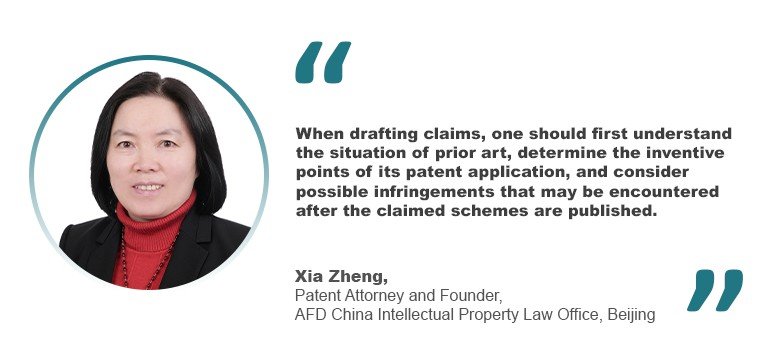“It is a tricky process, because the scope of the claim plays a pivot role in defining the invention,” she said. “Sometimes, when it is too broad, it may lead to lack of clarity on the invention. On the other hand, when the scope is too narrow, it could limit the exploration of the invention’s actual patentability.
Therefore, inventors need to undertake a thorough pre-patentability search to help them specify parts of the invention that are a potential scope of the invention to be protected as a patent.”
She added: “Additionally, since the claim must always be supported by the original disclosure of the invention, it is important for inventors and companies to ensure that all the essential part of the invented technology is included in the description. Thus, if the claims need to be amended at the later stage, inventors and companies would still have room of exploration therein.”
In the Philippines, some foreign patent applications filed are often submitted without considering whether the subject matter is allowable. “This is particularly common in patents involving computer programs,” said Genilo. “While some jurisdictions may recognize computer programs per se as protectable by patents to a certain degree, they are absolutely non-patentable in the Philippines. However, a claim directed to a computer program may still be patentable if it is drafted in a manner wherein the program instructions cooperatively work with a programmable device. In short, it cannot be a computer program or software by itself; it must exist and work with hardware. This would categorize the claim under computer-implemented inventions, which are allowable under Philippine patent law. This pitfall is generally avoidable if the applicant conducts thorough research about the specifics of Philippine patent law before filing their application in this jurisdiction.”
Another is the formal requirements with respect to claim drafting. In the Philippines, for example, multiple dependent claims cannot refer back to multiple dependent claims. Such type of claims is allowed in other countries.
Anticipating challenges
With the growing influence of case law on patent interpretation in the Asia-Pacific region, how can claim drafting be tailored to anticipate potential challenges from competitors who might try to exploit ambiguities in the claim language?
Zheng said, “It is necessary to study the patent interpretation involved in judicial interpretations and the practice of applying laws and judicial interpretations by the higher courts and the Supreme Court in typical cases and try to avoid using ambiguous languages in the drafting of claims.”
“The terms in the claims should be clear, logical, and unambiguous, ensuring that a person skilled in the art can accurately understand them for enablement. If any terms in the claims do not have a clear definition in the art or are different from their usual meanings, such terms should be defined in the specification. In drafting claims, It is important to sort out the technical schemes between independent claims and dependent claims, as well as between dependent claims, and pay attention to dependencies of the claims to avoid conflicts between technical schemes caused by improper dependencies,” she said.
Zheng noted that in addition, the specification should also provide necessary descriptions for each feature in the claims. “Especially for the features defined by function, the specification should describe how they can be implemented specifically. Moreover, the specification should also provide detailed descriptions of the beneficial technical effects achieved by the corresponding features,” she said.
Genilo added, “It is a recognized principle of claim interpretation that the terms used are given their plain meaning unless such meaning conflicts with the specification. Therefore, ambiguities in the claim language are simply addressed by employing clear and precise terminology. Using overly broad or vague expressions in the claims only increases the risk of easy invalidation by prior art, whether on the grounds of novelty or inventive step. However, above all else, the safest approach to prevent misinterpretation of the claims is to ensure they are strongly supported by the disclosure in the specification. This leaves no doubt as to how the terms in the claims should be interpreted.”
When it comes to the use of artificial intelligence, all three lawyers believe that while developments in the field of AI might appear promising, especially for patent drafting, at the end of the day, these are just “tools” whose effectiveness is just as limited as the actual capabilities of its user. Wulansari said that there is yet an AI tool that accommodates claim drafting in the Bahasa Indonesia language. “Therefore, we believe the effectiveness of using AI tools in claim drafting in Indonesia is currently unforeseeable. Direct involvement of inventors in the claim drafting still plays an essential role, especially when it comes to accuracy of reflecting the meaning of the relevant invention,” she said.
In drafting claims
In drafting claims, Zheng said that it is important to remember that it should be ensured that the claims belong to patentable subject matters specified in the patent law of each jurisdiction. “Under this premise, the claims should accurately reflect the technical schemes of the product or method invention, which makes such claims commercially attractive. Second, the description of the technical schemes in the claims should be clear, use standard terminology in a reasonable order and with appropriate generalization, meet the relevant legal requirements for drafting claims, and make the technical schemes clear and easy to read,” she said.
Moreover, for drafting a set of claims with an appropriate scope of protection, the drafting of the specification should also be given equal attention. “It is recommended to provide specific descriptions of technical parameters and technical effects in the specification, which will be more favorable for arguing on the inventiveness of the claims,” she said.
She added: “In addition, based on our practice, if an accused infringing technical scheme belongs to a technical scheme explicitly excluded in the specification or belongs to a technical scheme in the background technology, the court will not support the right holder’s claim of equivalent infringement. Therefore, attention should also be paid to the drafting of the specification.”
Wulansari added: “The process of claim drafting requires thorough research and strategies that would hopefully be beneficial to the applicants, or later, the patent holder. Although the inventor is the ‘mastermind’ of the invention, it is always our recommendation for the inventors or companies to seek professional assistance from a licensed IP consultant when it comes to claim drafting. A seasoned IP consultant is able to offer a different yet enriched perspective and strategies in claim drafting and can help to navigate the right direction in defining the scope of invention.”
Genilo said: “Patent law is essentially a balancing act of the legal, technical and commercial aspects of an invention.










